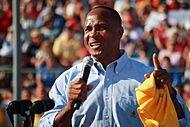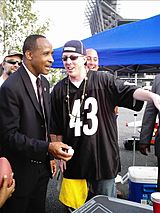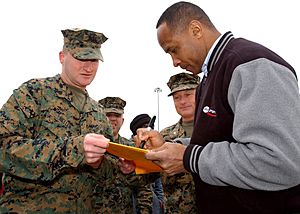Lynn Swann facts for kids
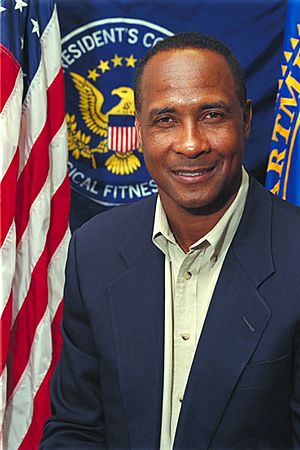
Swann in 2005
|
|||||||
| No. 88 | |||||||
|---|---|---|---|---|---|---|---|
| Position: | Wide receiver | ||||||
| Personal information | |||||||
| Born: | March 7, 1952 Alcoa, Tennessee, U.S. |
||||||
| Height: | 5 ft 11 in (1.80 m) | ||||||
| Weight: | 180 lb (82 kg) | ||||||
| Career information | |||||||
| High school: | Junípero Serra (San Mateo, California) |
||||||
| College: | USC (1970–1973) | ||||||
| NFL Draft: | 1974 / Round: 1 / Pick: 21 | ||||||
| Career history | |||||||
| As player: | |||||||
|
|||||||
| As administrator: | |||||||
|
|||||||
| Career highlights and awards | |||||||
|
|||||||
| Career NFL statistics | |||||||
|
|||||||
| Player stats at PFR | |||||||
|
Pro Football Hall of Fame
|
|||||||
|
College Football Hall of Fame
|
|||||||
Lynn Curtis Swann (born March 7, 1952) is a famous American former football player. He was also a sports broadcaster, a politician, and an athletic director. He is best known for his time with the University of Southern California and the Pittsburgh Steelers.
Swann was born in Alcoa, Tennessee. He played football as a wide receiver for the USC Trojans in college. He was considered one of the best wide receivers of his time. The Pittsburgh Steelers picked him in the first round of the 1974 NFL draft. With the Steelers, Swann won four Super Bowls. He was chosen for three Pro Bowls and was named MVP of Super Bowl X. Swann was added to the Pro Football Hall of Fame in 2001. He also joined the College Football Hall of Fame in 1993.
Contents
Early Life and Talents
Lynn Swann was born on March 7, 1952, in Alcoa, Tennessee. His family moved to San Mateo, California, when he was two years old. He grew up in Foster City.
Swann went to Junípero Serra High School. There, he was a star in football and track. He was also on the basketball team. Lynn Swann also had a strong interest in ballet. His basketball teammate, Peter Barsocchini, was inspired by Swann's love for ballet. This inspired him to write the movie High School Musical. Swann was an inspiration for the character Troy Bolton. In 1970, Swann won the state championship in the long jump. He even beat future Olympic gold medalist Randy Williams.
College Football Career
Swann went to the University of Southern California (USC) in Los Angeles. He played for the Trojan football team under coach John McKay. In 1972, his team had a perfect season and won the national championship. Coach McKay said Swann had "speed, soft hands, and grace." Swann earned a degree in public relations in 1974.
In 1971, Swann caught 27 passes for 305 yards and two touchdowns. He led USC in catches that year. In 1972, he rushed for 117 yards and caught 27 passes for 543 yards. He also scored three touchdowns. In 1973, Swann rushed for 99 yards. He caught 42 passes for 714 yards and six touchdowns.
Professional Football Career
The Pittsburgh Steelers picked Lynn Swann in the first round of the 1974 NFL draft. He was the 21st player chosen overall. The Steelers' 1974 draft class is known as one of the best ever. It included four future Hall of Famers: Swann, Jack Lambert, John Stallworth, and Mike Webster.
Swann played his entire NFL career with the Steelers. He wore jersey number 88. In his first year, 1974, he led the NFL in punt-return yards. He won his first championship ring with the Steelers in Super Bowl IX.
The 1975 season was a huge year for Swann. He caught 49 passes for 781 yards and led the league with 11 touchdowns. In the AFC championship game, he suffered a severe concussion. Many people were surprised when he returned to play in Super Bowl X. In that game, Swann caught four passes for a Super Bowl record 161 yards. He also scored a touchdown. This helped the Steelers win 21–17 against the Dallas Cowboys. He was the first wide receiver to be named Super Bowl MVP.
In 1978, the Steelers reached Super Bowl XIII. Swann caught seven passes for 124 yards. He scored the final touchdown for Pittsburgh in their 35–31 win over Dallas. The Steelers returned to the Super Bowl in 1979 for Super Bowl XIV. Swann caught five passes for 79 yards and a touchdown. Pittsburgh won 31–19 against the Los Angeles Rams. In total, Swann gained 364 receiving yards in his four Super Bowls. This was a Super Bowl record at the time.
Swann retired after the 1982 season. He had won four Super Bowl rings. In his nine-year career, he had 336 catches for 5,462 yards. He also scored 51 touchdowns. He was chosen for the Pro Bowl three times. He was also named to the 1970s All-Decade Team. Swann believed his dance training helped him on the football field. He even appeared on Mister Rogers' Neighborhood to talk about his love for ballet.
Swann was named to the All-Pro team in 1975, 1977, and 1978. He was elected to the Pro Football Hall of Fame in 2001.
NFL Statistics
| Legend | |
|---|---|
| Won the Super Bowl | |
| Super Bowl MVP | |
| Bold | Career high |
| Year | Team | GP | Rec | Yards | Avg | TD |
|---|---|---|---|---|---|---|
| 1974 | PIT | 12 | 11 | 208 | 18.9 | 2 |
| 1975 | PIT | 14 | 49 | 781 | 15.9 | 11 |
| 1976 | PIT | 12 | 28 | 516 | 18.4 | 3 |
| 1977 | PIT | 14 | 50 | 789 | 15.8 | 7 |
| 1978 | PIT | 16 | 61 | 880 | 14.4 | 11 |
| 1979 | PIT | 13 | 41 | 808 | 19.7 | 5 |
| 1980 | PIT | 13 | 44 | 710 | 16.1 | 7 |
| 1981 | PIT | 13 | 34 | 505 | 14.9 | 5 |
| 1982 | PIT | 9 | 18 | 265 | 14.7 | 0 |
| Career | 116 | 336 | 5,462 | 16.3 | 51 | |
Life After Football
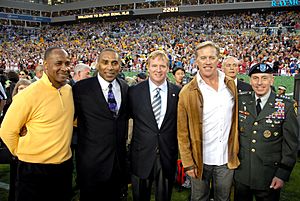
After retiring from football, Lynn Swann became a sports broadcaster for ABC Sports. He worked there from 1976 to 2006. He also hosted the TV game show To Tell the Truth for a short time. Swann made guest appearances on Mister Rogers' Neighborhood and The Paper Chase.
As a broadcaster, Swann covered many big events. These included the Winter and Summer Olympic Games from 1976 to 1988. He also covered the Iditarod Trail sled dog race, USFL games, and college football. He worked on Monday Night Football and covered horse races like the Kentucky Derby.
In 2009, Swann joined the Augusta National Golf Club. In 2010, he became part of the ownership team for the Pittsburgh Power. This was an Arena Football League (AFL) team that started playing in 2011. The team played in the same arena as the Pittsburgh Penguins. The Pittsburgh Power team stopped playing in 2014.
Swann also appeared as himself in the 1998 movie The Waterboy. He was inducted into the Rose Bowl Hall of Fame in 2013. On April 13, 2016, Swann was named the athletic director for the University of Southern California. He held this position until September 9, 2019.
Public Service and Politics
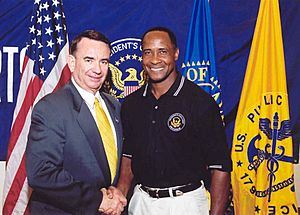
On June 20, 2002, President George W. Bush chose Lynn Swann to lead the President's Council on Physical Fitness and Sports. This council helps Americans stay active and healthy. In 2003, Swann and President Bush launched presidentschallenge.org. This website helped many people get active. They also started the "National Physical Fitness and Sports" month in May. Swann left this role in 2005 to consider running for governor.
Running for Governor
In 2004, Swann thought about running for Governor of Pennsylvania. He officially announced his plan on January 4, 2006. He chose Jim Matthews as his running mate. Swann's campaign focused on improving public transportation, property taxes, and law enforcement. He also wanted to help the Pittsburgh Penguins build a new arena.
Swann lost the election to Ed Rendell. Swann received 40% of the votes, while Rendell received 60%. If Swann had won, he would have been the first African American Governor of Pennsylvania.
Personal Life
Lynn Swann married Bernadette Robi in 1979. They later divorced in 1983. In 1991, Swann married Charena Shaffer, who is a psychologist. They have two sons who both played college football.
See also
- Bay Area Sports Hall of Fame
- Drew Crompton


